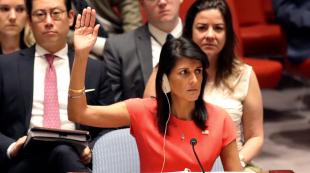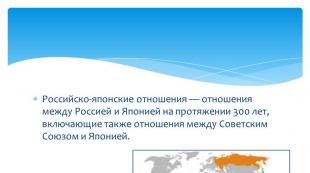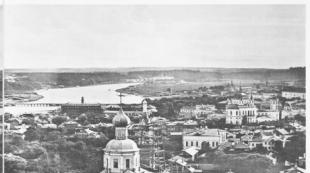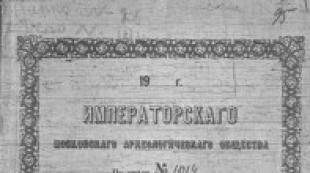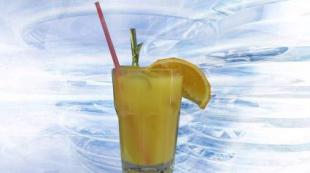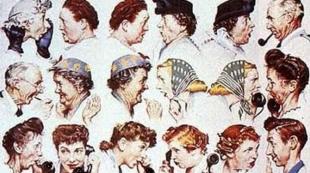Lesson summary of multiplication and division by 5. Lesson summary in mathematics on the topic "Divide by an integer" (grade 5)
The long-awaited bell rang and the lesson began.
I add, subtract, multiply and divide.
I know mathematics and that's why I love it.
Hello guys! Sit down.
Look into each other's eyes, smile, wish your friend a good working mood for the whole school day.
I also wish you a good mood
-– You and I have a reason to rejoice and smile, Santa Claus came to visit us with his snowflake assistants.
The numbers written on the snowflakes are: 3, 12, 5, 20.
– Read the numbers.
– Read in ascending and descending order.
– Divide the numbers into two sets.
– By what principle do we divide the numbers? (Divisible by 3 and not divisible by 3; divisible by 5 and not divisible by 5.)
– Name the largest single-digit number.
– This number is related to the topic of our lesson. Formulate the topic of the lesson. The topic of the lesson.
Today we will do strengthening exercises. What goals can you set for yourself when working to consolidate the material you have covered?
What character traits do you think will help you cope with tasks?
Working on lesson material
1) – Name the figures.
-What are these figures?
– What other figures do you know?
– Now remember what kind of voluminous figure you often see in winter? Especially during children's winter fun. (Ball)
-What does he look like? (Snowball)
- The children played snowballs. And this is what happened (answers are covered with snowballs).
5 . 3 5 . 6
2 . 5 8 . 5
5 . 4 5 . 9
7 . 5 5 . 5
2) Work using cards. (work in pairs).
– Imagine that you are at a skating rink. Holding hands, you skate together on the ice. You need to avoid slipping and use your knowledge of the 5 multiplication table to perform division. Support each other.
– What conclusion can be drawn? (Multiplication is related to division).
Checking the work.
– Along the paths between the snowdrifts we go out into the yard
3) Problem solving
Covered with snowdrifts
Hillocks, courtyards, paths
The birds can't find it
Not a grain, not a crumb.
And now they fly weaker and weaker
Crow, jackdaw, sparrow...
– What other birds can we see in winter?
– What are these birds called?
– What do you know about wintering birds?
– How can you help the birds?
– Imagine that birds have flown to your feeder. Let's count how many there are.
– You need to come up with several different solutions.
Arrived at the feeding trough
A pair of pugnacious sparrows.
And a couple of titmice too,
Pair of rock pigeons
And two pairs of bullfinches.
(2 + 2 + 2 + 2 + 2 = 10; 2 . 5 = 10).
– How many birds flew to the feeder?
– Which method is the most rational? Why?
4) A minute of exercise to prevent colds.
5)Work in notebook No. 1
– What does it mean to find the fifth part of a number?
- What do I need to do?
Numbers on the board: 12, 18, 15.
– Name the number in which we can find half, third and quarter of the number; a third of a number and a fifth of a number.
Physical education moment
I'm not afraid of frost.
I will become close friends with him
The frost will come to me,
He touches his hands, touches his nose.
So you shouldn't yawn,
Jump, run and gallop.
– We see a task under the snowdrifts. Expressions are written in pairs:
5 . 4 6 . 2 3 . 6 4 . 3
4 . 5 2 . 6 6 . 3 3 . 5
– Can we say that the meaning of the expressions in each pair is the same?
– What can you say about the first couple?
– What if I couldn’t find the meaning of the expressions? Could you answer the question posed? (Yes, the expressions contain the same numbers).
– What property of multiplication are we talking about? (Numbers can be multiplied in any order.)
– About which pairs can we say that the meanings of the expressions are the same?
– What can you say about the fourth pair? (The meanings are different, the numbers are different).
6). Group work.
A table is placed in a rectangle
– Try to understand the pattern on the basis of which the table is compiled. Continue it.
– What do you need to know to continue? (Multiplication table).
– Santa Claus has prepared a surprise for us. He brought a Christmas tree to us, because New Year is coming soon. We need to make her even more elegant. On your desks you have mugs of different colors. Now analyze your activities in class and those who think they completed the tasks:
quickly, correctly and independently hang a red toy on the Christmas tree;
who correctly, but slowly - blue;
who is correct, but with the help of others - yellow.
who quickly but correctly - a white toy.
– What a wonderful Christmas tree we have. Thank you very much for your work.
Repetition on the topic “Multiplication and division of natural numbers”
Lesson objectives:
improve skills in multiplying and dividing natural numbers;
development of skills to solve equations and word problems;
develop attention, memory, cognitive activity, literacy
mathematical speech;
cultivate discipline, responsibility, interest in the subject,
independence.
Epigraph to the lesson:
“The subject of mathematics is so serious that it is useful not to
miss opportunities to make it a little entertaining"
B. Pascal, French scientist.
During the classes
I. Organizational stage
The class's readiness for the lesson is checked. In notebooks we write down the number and class
Job. Slide 1.
II. Oral work
Answers on questions:
1. What is called multiplication? Components? (factors and product)
2. What are the numbers that are multiplied called? (multipliers)
3. What is the result of multiplication called? (work)
4. If any number is multiplied by one, what happens? (also a number)
5. If 1 is multiplied by any number, what do you get? (also a number)
6. What if any number is multiplied by 0? (0)
7. What if 0 is multiplied by any number? (0)
8. What is division called? Components? (dividend, divisor, quotient)
9. What if any number is divided by 1? (also a number)
10. What if any number is divided by the same number? (1)
11.What if 0 is divided by any number? (0)
12.What if any number is divided by 0? (doesn't make sense, you can't divide by zero!)
Let's write down the topic of the lesson. Slide 2
What goals will we set for ourselves?
The lesson is not quite ordinary. This is a fairy tale lesson. But to get into it, we
must get permission. Slide 3
Work on the topic of the lesson. Journey to the land of fairy tales.

To get admission, you need to knock on the first door. What a fairy tale behind it
lives? To find out we need to answer some more questions:
III. Mathematical dictation Slide 4
Students post their answers on their desks. Work in pairs.
Write down what it's called:
1. The number being divided by.
7. The number that is divided.
Let's check that the task is completed correctly:
Answers
1. Divider
2. Multiplier
3. Private
4. Multiplier
5. Private
6. Work
7. Dividend
8. Divider
Slide 5 (doors)
IV.

So we got clearance. Let's knock on the first door (one knock). Slide 6
What fairy tale lives behind it?
The first door opened, and behind it was the heroine of the fairy tale. Guess which one.
That's right "Little Red Riding Hood"
Let's try to find out what fairy tale lives behind the second door. To find out we need
Solve examples of multiplication and division.
Working with signal cards (yes – green, no – red)
Is it true: (showing cards)
b) x:16 = 4
a) 125 x = 1000
x = 8
x = 4
d) x 9 = 81
x = 9
c)75:x = 3
x = 25
e) x:71 = 0
x = 71
e) 47 x = 0
x = 0
g) 84:x = 6
x = 12
h) x 29 = 58
x = 2
Okay, you didn't do a bad job. You can open the second door (2
blow). The second door opened, and behind it was the hero of the fairy tale. Slide 7
Name this fairy tale.
That's right, Buratino.
V. Physical education minute.
Gymnastics for the eyes

Independent work
1 option
1) 145∙18=2610
2) 173∙160=27680
3) 7344:34=216
4) 6363:21=303
5) 18∙x=450; x=25
Option 2
1) 201∙32=6432
2) 120∙150=18000
3) 25280: 80=316
4) 9990:45=222
5) b∙23=575; b=25
VII. Lesson summary and reflection
It's time to return to our school. Today we visited a fairy tale.
What did we remember today, what did we learn?
Assess the degree of mastery of the material.
Hooray! I understand everything. Minor shortcomings, There were failures, but

there is something to work on. I will overcome everything.
VIII. Homework assignments. P. 3.2, p. 5455 – repeat. No. 219, p. 59
a)125x=1000
x = 8

b) x:16 = 4
x = 4
c)75:x = 3
x = 25

d) x 9 = 81
x = 9
e) x:71 = 0
x = 71

e) 47x = 0
x = 0
g) 84:x = 6
x = 12

h) x 29 = 58
x = 2
Mathematical dictation.
Write down what it's called:
1. The number being divided by.
2. The number one hundred in the expression 23 100
3. A number that is obtained by dividing numbers.
4. The number being multiplied by.
5. The number one hundred in the equality 300:3 = 100.
6. A number that is obtained by multiplying numbers.
7. The number that is divided.
8. The number one hundred in the expression 800:100.
Mathematical dictation.
Write down what it's called:
1. The number being divided by.
2. The number one hundred in the expression 23 100
3. A number that is obtained by dividing numbers.
4. The number being multiplied by.
5. The number one hundred in the equality 300:3 = 100.
6. A number that is obtained by multiplying numbers.

Lesson objectives: solve word problems in an arithmetic way, using the relationship between speed, time, distance; analyze and comprehend the text of the problem; simulate the condition using diagrams and drawings; reformulate the condition; build a logical chain of reasoning; critically evaluate the answer received, exercise self-control, checking the answer for compliance with the conditions.
Download:
Preview:
Lesson topic. Solving motion problems.
Class: 5 "b".
Lesson objectives:
Educational: the ability to solve word problems in an arithmetic way, using the relationship between time, speed and distance;
Developmental: development of the ability to analyze and comprehend the text of a task; simulate the condition using diagrams and drawings; reformulate the condition; build a logical chain of reasoning; critically evaluate the answer received, exercise self-control, checking the answer for compliance with the conditions;
Educational: to cultivate a conscious attitude towards academic work, to instill accuracy and hard work.
Planned results:
Personal: contribute to the formation of learning motivation, interest in expanding the acquired mathematical knowledge, development of resourcefulness and activity in solving problems, accurately and competently expressing one’s thoughts in oral and written speech.
Metasubject: contribute to the development of the ability to pose questions, compare, draw conclusions, create models of the objects being studied, see a mathematical problem in the surrounding life, and evaluate the final activity.
Subject: contribute to the development of the ability to work with mathematical text, calculate distance, speed, time, readiness to use mathematical knowledge in educational activities and in solving applied problems.
Lesson type: lesson of generalization and systematization of knowledge.
Equipment:
UMK:
Bunimovich E.A., Dorofeev G.V., Suvorova S.B. and others. Mathematics. Arithmetic. Geometry. 5th grade. Series "Spheres" (publishing house "Prosveshchenie") - textbook, notebook - simulator;
computer, multimedia projector, screen;
cards for independent work, cards with homework, problem sets.
Forms of work: frontal, pair and individual work in combination with various types of independent activities.
Lesson structure.
1. Organizational moment.
2. Motivation for students' learning activities.
“Consider unhappy that day or that hour in which you did not solve a new problem and did not add anything to your education.” (Ya.A. Kamensky)
These words will be the motto of our lesson. Some of you walked to school today, others traveled by bus or car. You need to calculate time, speed, distance every day. Air masses are moving around us; today the wind speed in our region is from 4 m/s to 6 m/s. Each of you should be able to make the connection between speed, time and distance.
3. Reporting the topic of the lesson, setting the goals and objectives of the lesson.
4. Oral exercises.
Opening speech by Polina Polyanskaya.
No knuckles, no pens, no chalk - oral counting
We do this work only with the power of our minds and souls!
On each table is the text of an oral count.
- Three horses ran in a harness for 15 km. How many kilometers did each horse run?
- Three horses traveled 15 km in 1 hour. How fast was each horse going?
- On a straight section of road, each wheel of a two-wheeled bicycle travels 5 km. How many kilometers did the bike travel?
- The electric train takes 70 minutes from Kursk to Solntsevo, and 1 hour and 10 minutes back. Which path does he spend more time on?
- Wind speed 3m/s. A seagull flies with a wind of 7 m/s. At what speed will it fly against the wind?
a) speed is the distance between two points,
b) speed is driving fast,
c) speed is the distance traveled by a body per unit time.
- Choose the correct statement:
a) to find the distance, you need to divide the speed by the time,
b) to find the distance, you need to divide the time by the speed,
c) to find the distance, you need to multiply the speed by the time.
In life, it is very important to be able to reason and analyze various situations.
5. Problem solving.
We analyze and reason everything together.
During an excursion into the forest, the students were overtaken by a thunderstorm. When the lightning flashed, the teacher began to count out loud the seconds on her watch, from the moment the lightning flashed to the moment when thunder was heard. She counted 15 s. The speed of sound (thunder) is 330 m/s. How far away was the thundercloud from them?
Then the children counted between subsequent flashes of lightning and thunder, first 13s, then 10s and 8s. Give advice to children on what to do in this situation.
The famous mathematician Jacques Hadamard said:
“Before solving a problem, read the conditions carefully.”
On each table is the text of the assignment. Each row performs one of the following tasks.
330*15=4950m.
330*13=4290m.
330*10=3300m.
330*8=2640m.
What conclusion can be drawn regarding the distance?
What would you do in this situation?
Consult everyone together and return home, as a thundercloud is approaching the children.
Wherever you are, always remember that you cannot buy health. The main task of everyone is to take care of their health.
6. We work with models.
In life we must remember that intelligence is good, but two are better. Now you are working in pairs.
Exercise book page 30 No. 69.
Checking the completion of tasks.
At what speed should a car move along Pervomaiskaya Street, where our school is located?
The car must move at a speed of 40 km/h.
What popular proverb should those behind the wheel remember?
7. Solving the Olympic problem.
Two skaters left the same point at the same time in opposite directions. After 3s, the distance between them became 21m. Find the speed of the second skater if the speed of the first is 4 m/s.
Sochi hosted 22 Olympic Games. This task will be dedicated to our figure skaters who became Olympic medalists.
Scheme for the problem. Slide No. 1.
How do skaters move?
What is the speed of the first skater?
What is the distance between the skaters?
What else is known in the problem statement?
What do you need to know to answer the problem question?
After analyzing and discussing the solution plan, students write out the solution to the problem in their notebooks, choosing a rational solution.
8. Physical education minute.
For warming up from behind the desks we rise to the start.
The physical education session was conducted by Dasha Soklakova.
Turn on the music.
Once - get up, stretch.
Two - bend over, straighten up.
Three clap three hands.
Three nods of the head.
By four – your arms are wider.
Five - wave your arms,
Six - sit quietly at your desk.
9.Independent work according to two options.
Option #1
Two trains departed simultaneously from the same point in opposite directions. The speed of the first train is 70 km/h, the speed of the second train is 50 km/h. What will be the distance between the trains after 5 hours?
Fill in the missing words, numbers and arithmetic symbols to solve the problem.
Solution
1 . What is the speed of the trains?
2. What will be the distance between the trains after 5 hours?
1 . What is the speed? cars?
2. After how many hours will the cars meet?
Answer:
Pick up simple pencils: you have a mutual check.
10. Work in groups.
Solving problems of varying levels of complexity. There are cards on the tables.
The scout reported to the commander that the train he was monitoring passed by him in 15 seconds, and the bridge passed completely in 45 seconds. The commander knew that the length of the bridge was 450m and quickly calculated the length and speed of the train. How did he do it?
Slide No. 2 was prepared by Dasha Aseeva.
I went with the dog to meet my dad. When the dog saw daddy,
she ran towards him at a speed of 300 m/min. Having reached him, she immediately ran to me. So she continued her run until we met. How far did the dog run if I walked at a speed of 50 m/min, dad walked at 60 m/min, and the initial distance between us was 440 m?
Slide No. 3 was prepared by Dima Kholodov.
According to the Zarnitsa game plan, 5 “A” takes up defense near the lake, and 5 “B” advances from a point located 2 km 300 m from the lake. To find out the enemy's intentions, the commander of 5 "A" sent out scouts who moved at a speed of 65 m/min. How many minutes will it take for reconnaissance to reach the enemy if 5 “B” advances at a speed of 50 m/min?
Slide No. 4 was prepared by Nastya Khlopova.
Checking the solution to problems of groups 1-3. Slide show.
I would like to wish you to solve new problems every day and bring them to class. After all, “Mathematics is mental gymnastics” - this is what the great Russian commander A.V. Suvorov said about our science.
11. Homework assignment.
Exercise book. No. 69 (c, d) p.31
No. 200 textbook.
Additionally.
Task No. 1.
A train 225 meters long travels at a speed of 54 km/h. How many seconds will it take the train to cross a 450 meter long bridge?
54000:3600=15m/s is the speed of the train.
450+225=675m is the total distance that will be covered by the beginning of the locomotive.
675:15=45s.
Answer: 45s.
Task No. 2.
Petya discovered that when his dad left for work, he forgot the documents he had prepared in the evening. Petya took the documents and ran to catch up with his dad. How many minutes will it take Petya to catch up with dad if he walks at a speed of 65 m/min, Petya runs at a speed of 80 m/min and dad manages to walk 90 m from the house?
The slide was prepared by Polina Polyanskaya.
12. Reflection.
During the lesson I worked actively/passively.
I am satisfied/not satisfied with my work in class.
The lesson material was clear/not clear to me,
Useful/useless
interesting/boring.
13. Summing up and grading.
During the lesson you were active, solved problems well, and answered questions correctly. Don’t forget what you have learned that is good, and what you still don’t know how to do, learn. This is what the first Russian prince Vladimir Monomakh wrote in “Teachings to Children.”
Thanks for your work in class.
Literature
- Mathematics. Arithmetic. Geometry. 5th grade: textbook for general education institutions. E.A. Bunimovich, L.V. Kuznetsova, S.S. Minaeva and others, “Enlightenment” 2013
- Mathematics. Arithmetic. Geometry. Problem book. 5th grade: manual for students Mathematics. Arithmetic. Geometry. E.A. Bunimovich, G.V. Dorofeev, S.B. Suvorova and others, “Enlightenment” 2013
- Exercise book. 5th grade: a manual for students of general education institutions / E.A. Bunimovich, L.V. Kuznetsova, S.S. Minaeva and others, “Enlightenment” 2013.
- Mathematics. Arithmetic. Geometry. Examiner's notebook. 5th grade: a manual for students of general education institutions / E.A. Bunimovich, L.V. Kuznetsova, S.S. Minaeva and others, “Enlightenment” 2013.
- Mathematics. Arithmetic. Geometry. Lesson thematic planning. 5th grade: a manual for teachers of general education institutions / L.V. Kuznetsova, S.S. Minaeva, L.O. Roslova, S.B. Suvorova and others, “Enlightenment” 2013
- Electronic supplement to the textbook. – M.: Education, 2013
- Postoeva O.A. / Ed. Chaplygina M.E. Cooperation, co-creativity between teacher and student is the path to educational motivation for schoolchildren when studying mathematics. Kursk 2014.
Open lesson on mathematics in 2nd grade "Multiplication and division tables by 5. The fifth part of a number." Educational and training complex "Primary school of the XXI century"
Sections: Teaching in primary school
Tasks:
Educational:
learn to find the fifth part of a number and apply this knowledge when solving problems;
consolidate knowledge of multiplication tables and division by 5;
continue to develop students’ ability to organize themselves and work at a given pace;
to develop cooperation skills through pair work and group work and creative activity of students;
Educational:
cultivate goodwill and a sense of mutual assistance;
promote the prevention of student fatigue;
Educational:
develop the ability to analyze
develop observation, logical thinking, mathematical abilities;
develop and enrich students’ speech;
intensify cognitive activity.
Equipment:
computer, multimedia projector, screen, presentation, board;
textbook "Mathematics 2nd grade" V.N. Rudnitskaya, T.V. Yudachev under the program “Primary School of the 21st Century”;
notebook "Mathematics" No. 2, 2nd grade, V.N. Rudnitskaya, T.Yu. Yudacheva.
During the classes
I. Organizational moment.
So, friends, attention -
The bell rang again.
Make yourself comfortable -
Let's start the lesson now.
II. Updating knowledge.
1. Game "Attention"
-Calculate and show the answer using daisies. Slide 2.
2. Review of the multiplication and division tables by 5.
- Open workbook No. 2, on p. 9 No. 5. Read the task.
-What needs to be done? (Underline examples whose answers are divisible by 5).
-What do you need to know for this? (meanings of expressions)
-Do it yourself.
-Exchange notebooks and do a mutual check. (slide 3.4)
3. Reading a series of numbers.
- Tell me what it is? (a series of natural numbers)
-Name the pattern.
-Write down in your notebook the numbers that are divisible by 5. (slide 5)
-Create all kinds of examples from the multiplication table and division by 5 in rows (30,35,40). Do a self-test. (slide 6)
-Complete the row, check.
III. Setting the lesson goal.
-Find the fifth of each number.
-Why was this task difficult? (we don't know how to find the fifth part of a number)
- What educational task will we set for ourselves?
- Today our task is to learn how to find the fifth part of numbers and practice using it.
IV. “Discovery” of new knowledge and primary consolidation.
Work on slide number 7.
- How do we find the fifth part of the numbers? (let's apply previous knowledge, use the textbook p.8)
- Read this rule and check with our statements.
-The work is organized along a chain with the following spoken:
"To find the fifth part of a number, you need to divide the number by 5."
They finish independently, starting with the number 25, followed by a check. (slide 7)
V. Physical training.
We will come out from behind our desks together,
But there's no need to make any noise,
Stand up straight, legs together,
Turn around, in place.
Let's clap our hands five times.
And we'll drown a little.
VI. Initial check of understanding.
a) Work on slide No. 8.
-Look at the drawing and name the geometric figure.
-What did you notice? (figures are divided into parts)
-Remember and name the shaded parts of the square.
b) Work in pairs.
-Draw a square with a side of 5cm, divide it into five equal parts, paint over one fifth of it.
-Check the execution correctly. (slide 8,9)
VII. Application of knowledge and skills in a new situation.
Solving problems No. 23 p.9.
-Read the problem. Tell us what the problem says.
(Collective formulation of the problem conditions)
-What do you need to know?
- What quantities do you need to know?
- Is it possible to start solving it right away?
- What needs to be done?
-Write down the solution to the problem yourself. (self-test slide 10).
Physical exercise.
Students repeat the movements after the teacher)
One - get up, pull yourself up, Two - bend over, straighten up, Three - clap your hands three times, Three nods with your head. Four - arms wider. Five - wave your arms, Six - sit down at your desk again.
VIII. Generalization and systematization of knowledge.
- Completing optional tasks. (slide 11)
Self-test. (slide 12,13)
IX. Information about homework.
D/z learn the rule on p. 8, r.t.s. 5 No. 11 (slide 14)
X. Reflection.
(slide 15)
- What topic of the lesson did we study today?
- What was easy for you to do?
- What difficulties did you encounter?
- Where can you find a hint if you are at a loss?
- Are you satisfied with your work in class?



